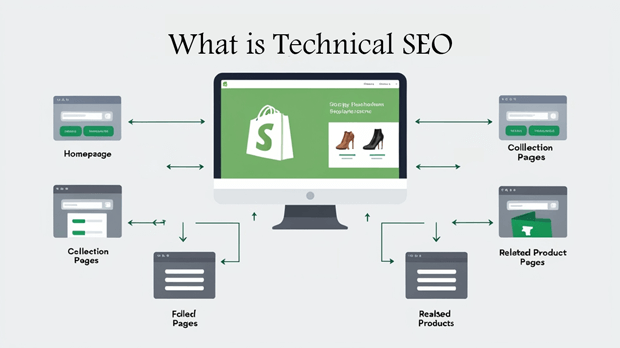Shopify makes it easy to build a beautiful, scalable online store. But when it comes to ranking high in Google search results, a polished front end isn’t enough.
You need to dive under the hood. That’s where technical SEO for Shopify comes into play,and it’s often the missing ingredient between a store that struggles with organic traffic and one that dominates its niche.
According to Backlinko, the top organic result in Google captures 27.6% of all clicks. That means technical SEO could literally make or break your Shopify store’s visibility.
In this guide, we’ll walk you through every step to optimize your Shopify store technically, from crawling and indexing to speed and structure, so you can outperform your competitors and earn Google’s trust.
Key Takeaways
- Discover the #1 technical SEO mistake most Shopify stores make (and how to fix it).
- Learn how Shopify’s URL structure can limit your SEO and what workarounds exist.
- Understand why schema markup is your secret weapon for rich results.
- See how to boost site speed on Shopify even if you’re not a developer.
- Find out how index bloat silently harms your rankings and how to clean it up.
- Use expert-backed tips to structure your store for better crawlability and rankings.
What Is Technical SEO for Shopify?

Technical SEO refers to optimizing the infrastructure of your Shopify store to help search engines crawl, index, and rank your content more effectively.
It ensures your site is structured in a way that Google understands and rewards.
Key Elements of Shopify Technical SEO
- Crawlability
- Indexability
- Site architecture
- Mobile usability
- Site speed
- Canonicalization
- Structured data (schema markup)
- XML sitemaps and robots.txt
These are crucial for Shopify stores competing in saturated markets where every SEO edge counts.
Recommeded Blogs for You:
How to Add Social Proof to Your Shopify Store: The Ultimate Guide to Boost Trust & Sales
Schema Markup for Shopify: Complete Implementation
Top Shopify Upsell Apps: Complete Comparison
Facebook Ads for Shopify: Complete Marketing Guide 2025
How to Optimize Technical SEO for Shopify Store
1. Shopify URL Structure: The Hidden SEO Challenge
Shopify automatically adds subfolders like /collections/ and /products/ to URLs. While functional, they aren’t SEO-friendly.
Problem:
- Lack of control over URL slugs
- Duplicate content through tag and filtered pages
- Canonical URLs often point to variants, not main product pages
Solution:
- Use canonical tags correctly (Shopify auto-handles this, but check with tools like Ahrefs or Screaming Frog)
- Avoid excessive product tags
- Link to main product URLs across your store
Pro Tip: Consider using an app like Plug in SEO to monitor these issues automatically.
2. Optimize Shopify Site Speed for Core Web Vitals
Site speed is a direct ranking factor, especially on mobile. According to Google, 53% of mobile users abandon sites that take more than 3 seconds to load.
Actionable Speed Tips:
- Compress images using TinyPNG or Crush.pics
- Remove unused Shopify apps that bloat your theme
- Use Shopify’s built-in lazy loading
- Minify CSS and JavaScript (Shopify does this by default, but audit for leftover bloat)
Use PageSpeed Insights to assess performance and Shopify Analyzer for Shopify-specific diagnostics.
3. Schema Markup: Unlock Enhanced Search Visibility
Adding structured data allows your pages to qualify for rich snippets in Google search,like product ratings, FAQs, and price.
Essential Schema Types for Shopify:
- Product schema
- FAQ schema (on relevant pages)
- Breadcrumb schema
- Review schema
You can add schema manually via theme code or use apps like:
Why It Matters:
According to a Milestone Research study, pages with rich results see a 20-30% higher click-through rate.
4. Crawlability & Indexing
Common Crawl Issues in Shopify:
- Too many low-value tag or filter pages indexed
- Soft 404s from removed products
- Unoptimized robots.txt blocking important content
Fixes:
- Use Google Search Console to monitor indexing
- Block tag pages in robots.txt using Shopify’s editable file (as of 2021 update)
- Remove or consolidate outdated product pages
Tools to Help:
- NoIndexly ‑ Sitemap Manager
- Google Search Console > Coverage
- Ahrefs > Site Audit
5. Internal Linking & Site Structure: Build a Crawlable Web
Search engines navigate your site like a human might. If pages are buried or disconnected, they lose value.
Best Practices:
- Keep important pages 3 clicks or fewer from the homepage
- Use breadcrumb navigation
- Link to related products, blog posts, and collections
- Maintain a flat, logical hierarchy
A study by Botify found that pages deeper than three levels in a website hierarchy experience 50% less traffic on average.
6. Mobile Usability & Core Web Vitals
Over 70% of eCommerce traffic now comes from mobile. Google’s mobile-first indexing means your mobile performance is SEO performance.
Optimization Tips:
- Use responsive themes from the Shopify Theme Store
- Avoid pop-ups that block content
- Optimize for tap targets and font size
- Test mobile usability via Google’s Mobile-Friendly Test
7. Shopify Apps That Help With Technical SEO
While Shopify is limited in some areas, there are apps that extend its SEO capabilities:
Top Technical SEO Apps for Shopify:
- GP JSON‑LD Schema for SEO: Schema automation for rich results
- Plug in SEO: On-page and technical audits
- Smart SEO: Schema, meta tags, and sitemap control
- SEO Manager: Advanced optimization and structured data
Choose tools that automate error detection and integrate well with your theme.
FAQ: Shopify Technical SEO
How do I access my Shopify robots.txt file?
Shopify made it editable in 2021. Go to Online Store > Edit Code > robots.txt.liquid to customize crawl directives.
Can I fully customize my URL structure in Shopify?
Not completely. Shopify forces certain folders like /products/ and /collections/. You can clean up slugs but can’t remove the folders.
Does Shopify support dynamic XML sitemaps?
Yes. Shopify auto-generates sitemaps at yourstore.com/sitemap.xml and keeps them updated. You can submit them via Google Search Console.
Why are some of my pages not showing in Google?
They might be blocked by robots.txt, have noindex tags, or are not linked internally. Use Search Console to investigate.
Is Shopify good for technical SEO?
Out of the box, Shopify has limitations, but with the right tweaks and apps, it can compete strongly on technical SEO.
Final Thoughts: Mastering Technical SEO on Shopify
Technical SEO for Shopify isn’t optional,it’s the foundation for all other SEO work. Without it, your content and keywords can only go so far.
By addressing crawlability, speed, schema, mobile UX, and internal linking, you create a Shopify store that’s both search-engine friendly and customer-centric.
Start with the basics, use the right tools, and make technical SEO part of your ongoing optimization strategy. Your rankings (and conversions) will thank you.




